Sticky mucous membranes - Study guides, Class notes & Summaries
Looking for the best study guides, study notes and summaries about Sticky mucous membranes? On this page you'll find 766 study documents about Sticky mucous membranes.
Page 2 out of 766 results
Sort by

-
NUR2063 Final Exam Study Guide / NUR 2063 Final Exam Study Guide QUESTIONS AND CORRECT ANSWERS VERIFIED ANSWERS GRADED A+
- Exam (elaborations) • 41 pages • 2024
-
- $13.99
- + learn more
NUR2063 Final Exam Study Guide / NUR 2063 Final Exam Study Guide QUESTIONS AND CORRECT ANSWERS VERIFIED ANSWERS GRADED A+ What is the difference between a sign and a symptom? - CORRECT ANSWER-Sign - Objective (Erythema, Edema, lesion) Symptom - Subjective (Headache, sore, tired) Na - Sodium - CORRECT ANSWER-136-144 mEq Hyponatremia - anorexia, gastrointestinal upset, poor skin turgor, dry mucous membranes, blood pressure changes, pulse changes, edema, headache, lethargy, confusion, ...
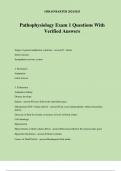
-
Pathophysiology Exam 1 Questions With Verified Answers
- Exam (elaborations) • 24 pages • 2024
-
- $11.49
- + learn more
©BRAINBARTER 2024/2025 Pathophysiology Exam 1 Questions With Verified Answers Stages of general adaptation syndrome - answer1. Alarm Initial reaction Sympathetic nervous system 2. Resistance Adaptation Limit stressor 3. Exhaustion Adaptation failing Disease develops Edema - answerExcess fluid in the interstitial space Dehydration (ECF volume deficit) - answerCan occur independently without electrolyte defects Decrease in fluid level leads to increase in level of blood solutes Ce...
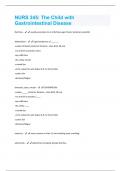
-
NURS 345: The Child with Gastrointestinal Disease Questions With 100% Correct Answers!!
- Exam (elaborations) • 19 pages • 2024
- Available in package deal
-
- $7.19
- + learn more
Diarrhea - usually secondary to an infectious agent (viral, bacterial, parasitic) dehydration - signs/symptoms of ______: -sunken fontanels (anterior fontanel - class @12-18 mo) -cry and fail to produce tears -cap refill time -dry, sticky mouth -crusted lips -urine output (no wet diaper 6-8, 12 hours kids) -cooler skin -dizziness/fatigue fontanels, tears, mouth - DEHYDRATION: -sunken _____ (anterior fontanel - class @12-18 mo) -cry and fail to produce ____ -cap refill time -dry, st...
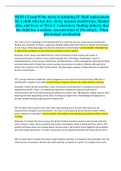
-
HESI 4 Exam/If the nurse is initiating IV fluid replacement for a child who has dry, sticky mucous membranes, flushed skin, and fever of 103.6 F. Laboratory finding indicate that the child has a sodium concentration of 156 mEq/L. What physiologic mech
- Exam (elaborations) • 23 pages • 2022
-
- $17.99
- + learn more
301. If the nurse is initiating IV fluid replacement for a child who has dry, sticky mucous membranes, flushed skin, and fever of 103.6 F. Laboratory finding indicate that the child has a sodium concentration of 156 mEq/L. What physiologic mechanism contributes to this finding? Correct Answer- Insensible loss of body fluids contributes to the hemoconcentration of serum solutes. Rationale: Fever causes insensible fluid loss, which contribute to fluid volume and results in hemoconcentrati...
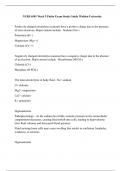
-
NURS 6501 Week 5 Patho Exam Study Guide Walden University
- Exam (elaborations) • 20 pages • 2024
-
- $10.00
- + learn more
Positively charged electrolytes (cations) have a positive charge due to the presence of extra electrons. Major cations include - Sodium (Na+) Potassium (K+) Magnesium (Mg++) Calcium (Ca++) Negatively charged electrolytes (anions) have a negative charge due to the absence of an electron. Major anions include - Bicarbonate (HCO3-) Chloride (Cl-) Phosphate (H PO4-) The main electrolytes in body fluid - Na+ sodium Cl- chlorine Mg2+ magnesium Ca2+ calcium K+ potassium Hyponatremia Path...
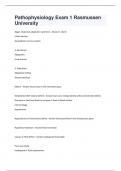
-
Pathophysiology Exam 1 Rasmussen University Questions and Answers Solved 100% Correct!!
- Exam (elaborations) • 26 pages • 2024
- Available in package deal
-
- $9.39
- + learn more
Stages of general adaptation syndrome - Answer-1. Alarm Initial reaction Sympathetic nervous system 2. Resistance Adaptation Limit stressor 3. Exhaustion Adaptation failing Disease develops Edema - Answer-Excess fluid in the interstitial space Dehydration (ECF volume deficit) - Answer-Can occur independently without electrolyte defects Decrease in fluid level leads to increase in level of blood solutes Cell shrinkage Hypotension Hypovolemia or fluid volume deficit - Answer-Decrease...
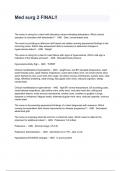
-
Med surg 2 FINAL!! Exam Questions And Answers
- Exam (elaborations) • 9 pages • 2024
- Available in package deal
-
- $11.49
- + learn more
Med surg 2 FINAL!! Exam Questions And Answers The nurse is caring for a client with laboratory values indicating dehydration. Which clinical symptom is consistent with dehydration? - ANS Dark, concentrated urine The nurse is providing an afternoon shift report and relates morning assessment findings to the oncoming nurse. Which daily assessment data is necessary to determine changes in hypervolemia status? - ANS Weight The nurse is caring for a client in heart failure with sign...
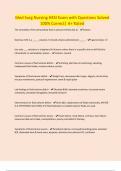
-
Med Surg Nursing HESI Exam with Questions Solved 100% Correct| A+ Rated
- Exam (elaborations) • 33 pages • 2024
-
- $13.39
- + learn more
The osmolality of the extracellular fluid is almost entirely due to - Sodium Dextrose 10% is a _____ solution. It should only be administered _____ - hyperosmolar; IV Use only ___ solutions in irrigations & infusions unless there is a specific aim to shift fluid to intracellular or extracellular spaces. - isotonic, neutral Common causes of fluid volume deficit. - Vomiting, diarrhea, GI suctioning, sweating, inadequate fluid intake, massive edema, ascites Symptoms of fluid volume deficit - ...
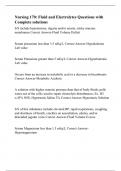
-
Nursing 170: Fluid and Electrolytes Questions with Complete solutions
- Exam (elaborations) • 5 pages • 2024
-
- $15.49
- + learn more
S/S include hypotension, olguria and/or anuria, sticky mucous membranes Correct Answer-Fluid Volume Deficit Serum potassium less than 3.5 mEq/L Correct Answer-Hypokalemia Lab value Serum Potassium greater than 5 mEq/L Correct Answer-Hyperkalemia Lab value Occurs from an increase in metabolic acid or a decrease in bicarbonate Correct Answer-Metabolic Acidosis A solution with higher osmotic pressure than that of body fluids; pulls water out of the cells; used to repair electrolyte dist...
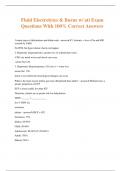
-
Fluid Electrolytes & Burns w/ ati Exam Questions With 100% Correct Answers
- Exam (elaborations) • 19 pages • 2024
- Available in package deal
-
- $12.49
- + learn more
Fluid Electrolytes & Burns w/ ati Exam Questions With 100% Correct Answers 3 major types of dehydration and define each - answer1. Isotonic: = loss of Na and H20 (caused by V&D) Na WNL but hypovolemic shock can happen 2. Hypotonic (hyponatremic): greater loss of sodium than water. -CM's are much worse and shock can occur -serum Na<130 3. Hypertonic (Hypernatremic): NA loss is < water loss. serum Na> 150 shock is less likely but neurological changes can occur What is the main...

Did you know that on average a seller on Stuvia earns $82 per month selling study resources? Hmm, hint, hint. Discover all about earning on Stuvia


